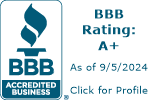Like clockwork, hurricane season extends from mid-May to late-November every year. Though Florida has always been susceptible to the paths of hurricanes — especially to storms that form over the Atlantic and travel near the Gulf of Mexico or the southeastern coast — storm threats have become more frequent in recent years.
A hurricane’s strength is measured by categories: from 1 (weakest) to 5 (strongest). Florida was hit by Category 4 storms every year between 2015 and 2018. In terms of property damage, 8 of the 10 costliest hurricanes in U.S. history have occurred in just the last 25 years. These trends don’t appear to be abating anytime soon.
Climate scientists predict rising ocean temperatures and higher sea levels attributed to global climate change have created a 45 percent to 87 percent increase in the frequency of Category 4 and Category 5 storms in the continental U.S.
Now more than ever, Florida residents need to be prepared.
Though hurricanes hit Florida’s coasts the hardest, all residents should be ready for hurricane season. At Maven Construction Group, we’ve provided water damage restoration and residential and commercial reconstruction services in Gainesville and other inland areas of North Central Florida after storms like Hurricane Irma (2017); no part of the state is exempt from hurricane risks.
From protecting loved ones to safeguarding your property from wind damage, here are hurricane preparation tips that you can use all year.
Hurricane Preparations To Make Now
Don’t wait to think about hurricane season until the first storm hits. Preparedness and knowledge can help you mitigate damage when possible and stay safe.
Sign Up For Storm Alerts
In today’s world, people are never far from their smartphones, which offer endless streams of tweets, texts, and news updates. If a storm is brewing, you’ll hear about it. But who’s to say that information will be fact and not opinion? Believing a hurricane is smaller or larger than in reality could affect your preparations. That’s why it’s critical you stay connected to a trusted source of storm warnings. The federal government offers several community alert systems that provide accurate, up-to-the-minute information. Combining these with a hurricane tracker app, such as the NOAA Weather Radar, ensures you’ll be aware of what’s happening near you.
Learn Your Area’s Hurricane Risk Level
Anyone who’s seen hurricane news coverage knows that storm paths are unpredictable. However, historical data at least provides some insight into how frequently your area has been hit by storms, which hints at the likelihood of another one coming. The National Oceanic and Atmospheric Administration (NOAA) has an interactive map of historical hurricane tracks that proves informative. Though everyone should learn of proper hurricane preparedness, those in storm-prone areas should be the most vigilant.
Invest In Hurricane-Proofing Measures
Given the awesome power of Mother Nature, storm damage restorations are rarely entirely preventable. However, you can still reduce the chances that your home or business will require water damage remediation or mold removal by making smart investments.
Storm shutters, for example, protect window glass from breaking from impact with windswept debris. Some shutters are permanent fixtures that complement the exterior architecture, while others are removable panels that go up or come down in minutes.
Another wise investment is routine tree trimming services. Many Gainesville homes have large, mature trees outside. Trimming the dead branches eliminates potential debris that could cause property damage.
Rain is something else to worry about. Water accumulation during storms leads to flooding, then water damage and mold. Clearing gutters of leaves and dirt and replacing damaged gutter sections ensures that stormwater will be directed away from the walls and the foundation, where it could otherwise cause structural damage.
As a final incentive, consider that storm shutters, tree trimming, and new gutters don’t just make a building more hurricane-proof. These investments also increase the property value, a win-win proposition.
Keep A List Of Emergency Contacts
The contacts saved in your phone aren’t very useful if your phone battery dies or the cell towers fail. That’s why you need a backup hard copy of your contacts list, such as a notebook stored in a waterproof bag. In addition to phone numbers, email addresses, and physical addresses for family and close friends, write down contacts for emergency services, such as hospitals, evacuation sites, and restoration companies.
Maven Construction Group should be included in everyone’s emergency contacts. Count on us after a hurricane to provide emergency water removal, wind damage repairs, and other restoration and construction services, so that your home or business can return to habitable conditions. To find out how we can help with hurricane restorations, contact our residential and commercial restoration company.
Stock Up On Materials & Supplies
In the days leading up to a hurricane’s arrival, there is usually a run on plywood, flashlights, bottled water, and other essentials. If you have a storage room at your house or business, stock up on these items earlier in the season: emergency hurricane-proofing materials (plywood, packing tape), energy sources (a generator with fuel, batteries), and non-perishable foods. Tools such as a shovel, rake, and handsaw can also come in handy for clearing any debris that blocks your travel after the storm. And if internet access is something you can’t live without, consider having a battery-operated 4G hotspot.


